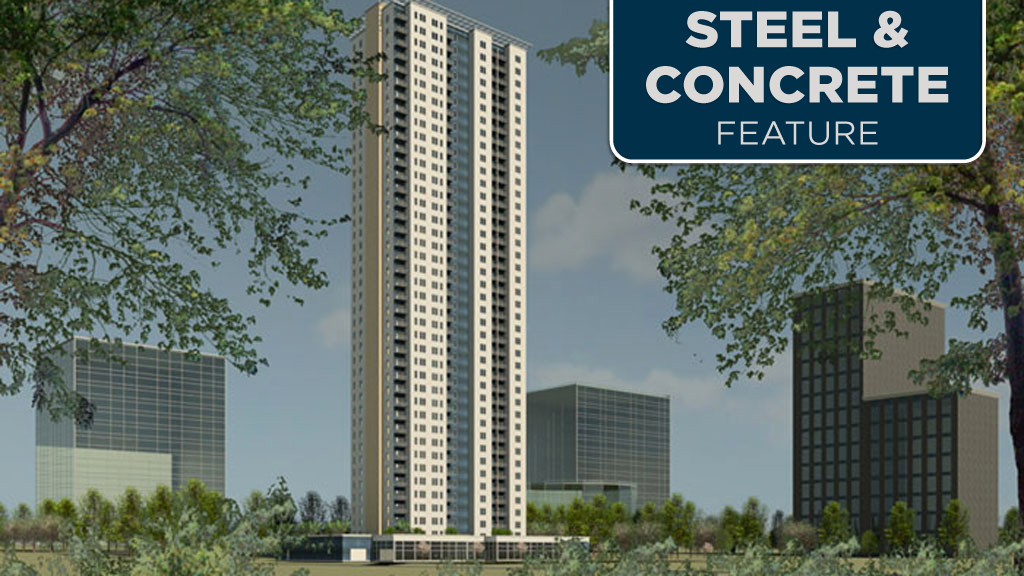Most are probably familiar with the making of steel. At its most basic, it begins with the creation of iron through a mix of lime ore, iron ore and coke super-heated in a blast or electric arc furnace. Several more steps follow, including the removal of excess carbon and other impurities, and processes needed to reach the desired composition. The molten steel is then either cast or formed into various shapes and lengths by “hot rolling”.
Great quantities of heat and raw material are required to create this structural steel, bringing attention to the carbon and gaseous emissions associated with the overall process. According to global consultancy McKinsey, eight per cent of the world’s carbon emissions can be traced to the manufacturing of steel.
Then there is steel’s lesser-known cousin, cold formed steel (CFS). It’s important to differentiate it from its hot-rolled relative.
Although CFS is derived the same way as hot rolled steel at the outset, it is instead made into thin strips, cooled, and then formed into C-sections, plates, flat bars, and other shapes to the desired thickness through a series of dies using rolled-formed machines. A protective coating of zinc is applied at the conclusion. Since no further heat and GHG emissions are required to form the shapes, as with hot-rolled steel, CFS skips those associated carbon emissions.
While structural steel has been ubiquitous at large building sites for decades, it’s bulky and heavy. On the other hand, CFS is lightweight. It excels as load-bearing structural elements, such as framing and joists, due to its exceptional high strength-to-weight ratio. That’s making CFS increasingly the steel of choice for innovative projects of all shapes and sizes.
CFS not only has lower production costs than structural steel, but it also allows faster build times which, in turn, lowers costs even more. The efficiency of CFS is evident when delivered to sites pre-cut and labelled, complete with electrical and plumbing cut-outs. Fewer numbers of highly-skilled workers are needed, and only usually equipped with power drills and fasteners. On-site welding or cutting is seldom required.
Light weight and ease of assembly has made CFS increasingly popular with manufacturers of factory-built wall panels and floor assemblies. A CFS joist or wall panel can be picked up by a few crew members. Quick assembly of prefabricated components, often without crane assistance, means further savings in construction time. For example, estimations of time savings erecting the Children’s Hospital of Philadelphia were 14 days per floor, according to contractor PDM.
“Panelization solves the labor shortage because 80 per cent of the work to construct the building is now done inside a plant instead of on site,” Kevin Wallace, founding principal of DSGNworks in Texas, told the Steel Framing Industry Association. “It can reduce the timeline of a project by two months if you’re working with the right general contractor.” Noting how the price of wood has tripled in cost year-over-year, Wallace adds that CFS also resolves cost of material issues. Making CFS more popular today is also the fact that most CFS is made from 75 to 90 per cent recycled content and usually blended in a lower-emitting electric arc furnace. Unlike concrete and mass timber, CFS is potentially 100 per cent recyclable after initial use, sometimes in whole component form.
Addressing CFS’s environmental benefits, the SFIA has released a tool for contractors, building owners, architects, and those seeking to deliver advanced building designs that meet the latest standards of LEED and other sustainable programs. With this latest EPD, CFS products made by the listed companies will be covered with an EPD through to May 2026.
Also, important today is resiliency in building design. Here again CFS excels. It is highly ductile, meaning it can bend or stretch without breaking when force is applied. This higher degree of resistance to lateral loads, uplift, and gravity loading, makes it ideal in areas at risk to seismic or high wind events.
Being a significantly lighter building material compared to alternatives such as timber, concrete and masonry can result in reduced construction costs for lateral force resisting systems and foundations. The lighter weight of cold-formed steel also allows for lower transportation costs.
Much has been made recently about the advantages of Mass Timber Construction in terms of its apparent environmentally-friendly embodiment of carbon. Yet as described above, many of MTC’s attributes are available with cold formed steel as well.
However, from a design standpoint, MTC can sometimes be at a disadvantage to CFS.
Mass timber beams need to be deep in profile in order to deliver the required strength over normal spans within a building structure. That thickness can result in higher floor-to-ceiling heights, possibly reducing the number of floors achievable within allowed building height restrictions. The slim profile possible with cold formed steel has the advantage, offering the potential for greater occupancy density.
For example, thanks to a slim, six-inch structural floor design using CFS, the Four Points Sheraton Hotel built at the Kelowna Airport in British Columbia was able to overcome strict building height zoning restrictions and incorporate an additional floor without compromising the spaciousness of the ground or guest floor rooms.
Similar to mass timber, CFS is breaking through previously accepted height barriers.
To determine its potential upper limits, the SFIA commissioned Patrick Ford, principal at Matsen Ford Design in Waukesha, Wisconsin, to create a virtual CFS-framed high-rise.
At the American Iron and Steel Institute meeting in April 2016, Ford unveiled the SFIA Matsen Tower, a 40-story residence. “The SFIA Matsen Tower has opened the door to a new way of incorporating CFS framing into high-rise buildings,” said the association.
The sky may be the limit for cold formed steel.











Recent Comments
comments for this post are closed